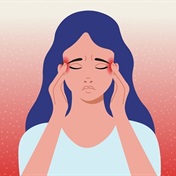Teenagers who are overweight, get little exercise, or smoke may be more likely than their peers to have recurrent headaches, researchers reported Wednesday.
Norwegian researchers found that among nearly 6,000 13- to 18-year-olds they assessed, those who were overweight, sedentary or who smoked were more likely to report suffering recurrent headaches in the past year including both migraines and common tension-type headaches.
The findings, published in the journal Neurology, do not show whether those lifestyle factors may raise teenagers' risk of developing frequent headaches in the first place.
But they raise the possibility that addressing kids' weight, smoking or exercise levels could help prevent or manage headache problems, senior researcher Dr. John-Anker Zwart, of Oslo University Hospital in Norway, told Reuters Health in an email.
The results mirror those that have been seen in adults with recurrent headaches; but the role of lifestyle in teenagers' headaches has rarely been studied, Zwart said.
The study
The study "is an important step in clarifying the effects of lifestyle factors on headache," according to the authors of an editorial published with the report.
And it "sets the stage" for looking at the effects of treatments focused on weight, smoking and exercise, write Dr. Andrew D. Hershey, of Cincinnati Children's Hospital Medical Center, and Dr. Richard B. Lipton, of Albert Einstein College of Medicine in New York.
For the study, Zwart's team interviewed 5,847 teenagers about a number of health and lifestyle factors, including any headaches they'd suffered in the past year not related to a cold or other acute illness.
Overall, 36 percent of girls and 21 percent of boys said they'd had recurrent headaches in the previous year. Tension-type headaches were most common, but one-quarter of girls with recurrent headaches reported migraines, as did a similar percentage of boys.
In general, rates of smoking, overweight and low physical activity defined as exercising less than twice per week were higher among teens with recurrent headaches compared with their peers.
Among boys, 19 percent of those with headaches were overweight, versus 15 percent of those who were headache-free; 31 percent versus 25 percent reported low exercise levels; and 20 percent versus 15 percent said they currently smoked.
Among girls, 20 percent of those with recurrent headache were overweight, compared with 14 percent of their headache-free peers; 37 percent versus 32 percent had low activity levels; and 27 percent versus 18 percent smoked.
The researchers found that each of the three factors was linked to an increased risk of headache problems, after controlling for the effects of the other two lifestyle factors, as well as age and gender.
Overweight teens were 40 percent more likely to have recurrent headaches than their peers with none of the three negative lifestyle factors. Those with low activity levels had a 20 percent increase in their risk, and smokers had a 50 percent increase.
Moreover, teenagers with all three unhealthy lifestyle factors showed the highest risk of recurrent headaches. Nearly 55 percent reported headache problems, compared with 24 percent of teenagers who were normal weight, non-smokers and exercised at least twice per week.
The findings leave open the question of whether excess pounds, smoking or inactivity are risk factors for recurrent headaches, or whether they may exacerbate existing headaches making them more frequent or intense, according to Hershey and Lipton.
Large studies that follow participants over time are needed to answer those questions, they point out.
With smoking, for example, it is plausible that tobacco could act as a headache trigger. On the other hand, people with frequent headaches may be more prone to depression or anxiety, for instance which could, in turn, have some of them reaching for cigarettes.
Zwart's team agrees that mental health and other factors, like families' socioeconomic status, may help explain the relationships among smoking, weight, exercise and recurrent headaches.
However, positive lifestyle changes are bound to bring teenagers health benefits.
"The take-home message," Zwart said, "is that it is worthwhile to try preventive measures and encourage positive lifestyle changes in adolescents with recurrent headaches, which includes stopping smoking, better and healthy dietary habits, as well as regular exercise." (Reuters Health/ 19 August 2010)
Read more: Happy ending to headache misery




 Publications
Publications
 Partners
Partners










